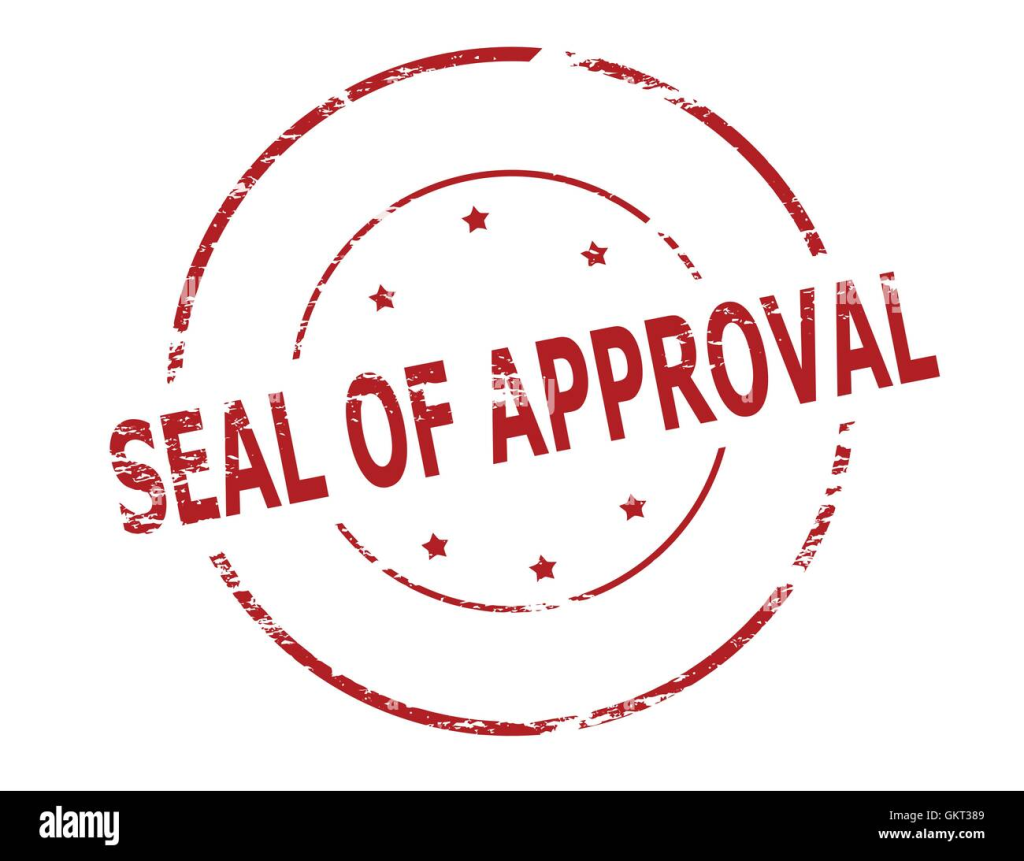
A Seal of Approval is more than just a symbol or certificate—it represents trust, credibility, and quality. In today’s competitive market, where consumers are bombarded with countless options, a seal can influence decisions and differentiate a product, service, or brand. From food products and electronics to educational institutions and online services, the seal acts as a mark of reliability and reassurance.
Businesses and organizations seek seals of approval to demonstrate compliance with standards, industry regulations, or consumer expectations. For customers, these seals are quick visual cues that reduce the risk of making a poor choice. They signal that the product or service has been independently evaluated and meets a defined set of criteria.
In 2025, the role of a seal of approval is evolving. It is no longer limited to printed labels on packaging; digital seals, online certifications, and badges on websites or apps have become essential tools for establishing credibility in the virtual marketplace. This article explores the concept of a seal of approval, its history, types, importance, and how it influences consumer behavior and business success today.
Understanding the Seal of Approval
A seal of approval is an official mark or emblem that indicates a product, service, or organization has met specific standards or quality criteria. These standards are usually set by recognized authorities, professional organizations, or independent third-party entities. The seal provides assurance to consumers that they are making a safe, reliable, and valuable choice.
Historically, seals of approval date back centuries. In ancient times, kings and governments used seals to signify authenticity and authority. Over time, the concept evolved to include commercial products and services. Today, a seal of approval can appear in many forms, including physical labels, certificates, holographic stickers, and digital badges on websites and apps.
Seals of approval are prevalent across industries. In the food and beverage industry, they indicate safety, nutritional standards, or organic certification. In electronics and home appliances, they signify energy efficiency or safety compliance. Educational institutions and professional organizations use seals to verify accreditation or achievement. Digital platforms also use badges or certifications as a virtual seal of approval, helping users trust online services, software, and content creators.
By understanding the meaning and purpose of a seal of approval, both consumers and businesses can recognize its value as a tool for building trust and credibility.
History and Evolution of the Seal of Approval
The concept of a seal of approval has deep historical roots. In ancient civilizations, seals were used to mark documents, coins, and letters, proving authenticity and authority. Kings, officials, and guilds relied on these seals to prevent forgery and demonstrate legitimacy.
As commerce grew, seals became integral to trade. Merchants used seals on goods to certify origin, quality, or compliance with standards. Consumers relied on these visual markers to identify trusted sources and avoid counterfeit products.
In the modern era, especially during the industrial revolution, the seal of approval transitioned from physical stamps to standardized certifications. Regulatory bodies, industry associations, and professional organizations began awarding seals to products, services, and institutions that met specific criteria. These included safety certifications, quality assurance marks, and awards of excellence.
With the rise of digital technology, seals of approval have entered the virtual world. Online reviews, digital badges, and certificates of verification serve as modern seals of approval. They provide credibility in e-commerce, software, online education, and content creation, extending the historical role of assurance into a digital context.
The evolution of the seal of approval reflects its enduring significance. While the medium has changed—from wax seals to holograms and digital badges—the core purpose remains the same: to build trust, communicate quality, and provide assurance to stakeholders.
Types of Seals of Approval
Seals of approval vary widely depending on their purpose, industry, and issuing authority. Understanding these types can help consumers and businesses recognize their significance.
Quality Seals signify that a product or service meets a recognized standard of quality. They often come from independent organizations or industry associations. These seals assure consumers that the item has been tested and verified for performance, durability, and safety.
Safety Seals are common in electronics, toys, and food products. They indicate that the product complies with safety regulations and has passed inspections. Examples include electrical safety marks or health authority certifications for consumables.
Environmental Seals focus on sustainability and eco-friendliness. They signify that a product or service adheres to environmental standards, such as energy efficiency, organic production, or recyclable materials. These seals are increasingly popular as consumers become more conscious of their ecological impact.
Professional or Educational Seals indicate accreditation or achievement. Schools, universities, and professional institutions often use seals to certify that an individual or program meets educational or professional standards. These seals convey legitimacy and value in academic and professional settings.
Digital Seals are used online to certify authenticity, security, or verification. E-commerce platforms, software, and websites display digital seals to show compliance with security standards, ethical practices, or user satisfaction guarantees.
By recognizing the different types of seals, consumers can make informed decisions, and businesses can strategically pursue the appropriate certifications to enhance credibility and marketability.
Importance of a Seal of Approval
The importance of a seal of approval cannot be overstated. For consumers, it acts as a shortcut to trust, signaling that a product or service has undergone scrutiny and meets a recognized standard. This reduces uncertainty and helps them make informed choices.
For businesses, a seal of approval can be a powerful marketing tool. It differentiates products from competitors, builds brand credibility, and increases customer loyalty. Displaying a seal prominently on packaging, websites, or promotional materials signals commitment to quality and reliability.
Seals of approval also enhance the perceived value of a product. Consumers are often willing to pay a premium for items that carry recognized certification marks. The seal communicates that the business prioritizes excellence, safety, and ethical practices.
In online marketplaces, seals of approval are particularly valuable. They provide reassurance in a virtual environment where physical inspection is impossible. Digital badges, verified reviews, and security certifications serve as seals of approval, reducing hesitation and increasing conversion rates for e-commerce platforms.
Ultimately, seals of approval bridge the gap between businesses and consumers, fostering trust, enhancing reputation, and supporting informed decision-making in an increasingly competitive and digital marketplace.
How a Seal of Approval Impacts Consumer Behavior
Consumers rely on visual cues and certifications when evaluating products and services. A seal of approval provides an immediate signal that an item is trustworthy and has met a standard of quality or safety.
Studies show that products displaying recognizable seals of approval are more likely to be chosen over similar products without certification. Consumers perceive these items as higher quality and safer, which can influence purchase decisions.
Seals of approval also foster long-term brand loyalty. When customers repeatedly encounter certified products that meet their expectations, they develop trust in the brand and are more likely to recommend it to others.
Additionally, in digital environments, seals of approval such as verified badges or security certifications reassure users about online transactions, data privacy, and content authenticity. This can significantly reduce hesitation, increase confidence, and drive engagement.
The psychological effect of a seal is simple yet powerful: it reduces perceived risk, provides reassurance, and builds trust—all critical factors in consumer decision-making in 2025.
Obtaining a Seal of Approval
Obtaining a seal of approval requires meeting specific criteria set by the issuing authority. The process often involves evaluation, testing, and verification. Businesses seeking certification must ensure that their products or services comply with established standards.
The first step is identifying the appropriate certification relevant to your industry. This could be a safety standard, quality benchmark, environmental certification, or professional accreditation. Next, businesses submit their product or service for assessment, which may involve testing, documentation, or on-site inspection.
Once compliance is verified, the issuing authority awards the seal, which can then be displayed on packaging, websites, or promotional materials. Regular audits or recertification may be required to maintain the seal, ensuring ongoing adherence to standards.
Obtaining a seal of approval not only improves consumer trust but also provides marketing leverage. Certified products are often highlighted in promotions, increasing visibility and credibility in the marketplace.
Digital Era and Seals of Approval
In 2025, seals of approval have expanded beyond physical products to the digital realm. Online businesses, apps, websites, and digital content creators now rely on digital certifications to build trust.
Digital seals can indicate security compliance, verified accounts, high-quality content, or ethical practices. They act as virtual badges, helping consumers and users quickly identify trustworthy sources.
The digital era has made seals of approval more versatile, interactive, and essential for credibility. They serve as key indicators of authenticity, reliability, and professionalism in a highly connected world.
Conclusion
A seal of approval is a powerful symbol of trust, quality, and credibility. From historical origins to modern digital applications, it continues to guide consumers and support businesses. In 2025, both physical and digital seals play a critical role in building confidence, influencing decisions, and differentiating products and services in competitive markets. By understanding its importance, types, and impact, consumers can make informed choices, and businesses can leverage certification to strengthen reputation and success. The seal of approval remains an enduring mark of excellence and assurance.

